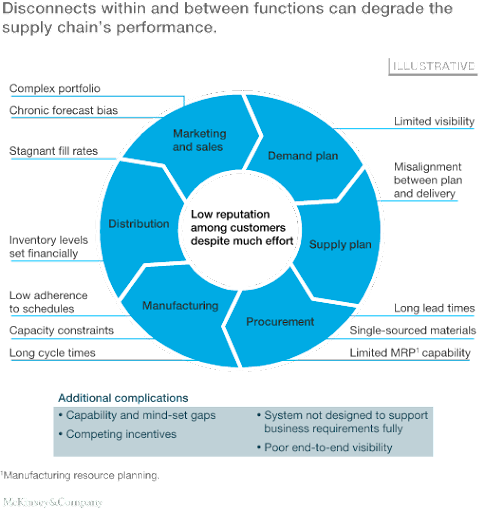
How Can Process Mining Help CPGs and Retailers With Planning and Forecasting?
Planning and Forecasting has never been easy, but when everything is unpredictable, how are you supposed to be able to avoid the dreaded empty shelf and disappointed customer? The answer may lie in process mining.
First things first, let’s put it out there: Planning and Forecasting has always been tough. There’s nothing like major business dependencies balancing on the readings of a crystal ball (even a well-informed, data-led one) to make a job stressful. Sometimes with so much of the narrative around the pandemic, it’s easy to forget that.
In fact, the current supply chain issues are a direct continuation of issues everyone was facing years ago. Other than some glaring omissions in the “Additional complications” section, this chart from McKinsey could have been from 2022, not 2017 (when it was published):

But the pandemic has certainly acted as an amplifier. Which has pushed some of these issues over the edge from ‘this is something we need to fix’ to ‘we’re losing customers’.
So, let’s look at what the key requirements for any Planning and Forecasting function in 2022, then talk about how process mining can help you reach these requirements.
3 key requirements for Planning and Forecasting in 2022
In order for Planning and Forecasting to continue to thrive in this unpredictable environment, it needs to be:
Connected: It doesn’t matter how well the independents tiers of your supply chain (like finished goods requirements to manufacturers, or manufacturing requirements to suppliers) are managed, if you don’t have an understanding of how the entire supply chain will operate, you can’t plan efficiently and just-in-time becomes just-no-luck. By having a single source of truth for how everything operates, departmental silos start breaking down, and smoother transitions become standard practice.
Specific: In order to forecast what’s going to happen, you need a crystal clear understanding of what has happened. Which means understanding not just what has happened in the past, but why it happened. You need to be able to see what the individual impact of each action you made was on all the different customer segments you have. And you need to be able to identify if there’s demand in areas you hadn’t planned for.
Flexible: There’s no two ways about it, in 2022, if your info isn’t real-time, it isn’t worth the paper it’s printed on (and if you’re actually printing it, that’s a red flag). Because everything is shifting so dynamically, you need to have a full understanding of how your business is operating in real-time, and you need to have advanced tools like automation and AI integrated into your planning and forecasting tools, so you’re responding to events before you even know they’ve happened.
How can process mining help with Planning and Forecasting?
Now, if you’re reading this and you’re from a CPG company or retailer (which I imagine you are, unless you just have a penchant for B2B blogs), someone in your company is probably already thinking about process mining in functions like Order Management or Accounts Payable.
But there’s huge scope for you to use it in Planning and Forecasting too. Process mining helps you reveal and fix the hidden inefficiencies in your processes, so you can perform at levels you never thought possible.
It acts like an X-Ray for your entire function, showing exactly what happens at every stage of every process, so you get a zoomed-out, completely objective view of what’s happening and why it’s happening, so you’re better able to predict what will happen in the future.
Then it acts as a brain for your processes, intelligently helping you to create smooth, automated, optimized workflows. And because it’s all real-time, it means you can react dynamically to any changes in our current turbulent landscape.
Want to see how we’re helping Reckitt with its digital transformation strategy? Check this out.




